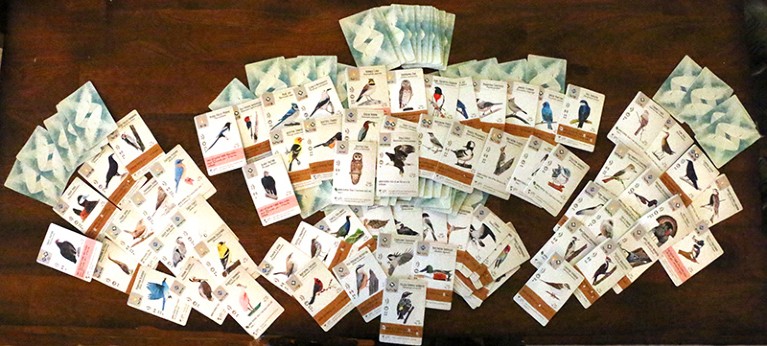
Wingspan uses egg tokens, bird cards, food dice and boards that fold like field notebooks.Credit: Kim Euker
Wingspan Stonemaier Games (2019).
Birdwatchers are list-makers, totting up species they have seen in their lifetimes, on holiday, from their office windows. Designer Elizabeth Hargrave has harnessed that impulse in her highly original board game, Wingspan, in which players compete to discover birds and attract them to wildlife reserves. But will non-birders find it exciting? To find out, I tested the game with a team of academics, graduate students, a biodiversity analyst and older children.
Each player’s board features a network of reserves: forest, grassland and wetland. To attract birds (represented on cards) to one of your reserves, you need food: insects for a chimney swift (Chaetura pelagica), for instance, or fish for an American white pelican (Pelecanus erythrorhynchos). You win points (feathers) according to the species — one for a house wren (Troglodytes aedon), eight for a golden eagle (Aquila chrysaetos).
You’re not, however, just attracting birds to get points. You are also effectively building a biodiversity engine. It’s a challenge, a biology lesson and nail-biting fun. There are numerous routes to victory, from specializing in certain types of bird to amassing eggs. This is a thoughtful and strategic game with many interlocking parts.
It’s also visually gorgeous — an obvious labour of love. Food is represented on the sides of chunky wooden dice that roll out of a bird box. There are dainty, pastel-hued egg tokens, and the game boards fold up like field notebooks. Each of the 170 unique cards shows a different North American species, so superbly drawn that it wouldn’t look out of place in a field guide. And the cards feature key details, from what the species eats to how many eggs it lays, and a distinguishing fact — say, that the common nighthawk (Chordeiles minor) is crepuscular, hunting insects at dawn and dusk.

Birds are depicted on 170 species cards.Credit: Kim Euker
Strategy is not simple. At each turn, you can either place a bird in one of your reserves or ‘activate’ a reserve so that, for example, the grassland triggers egg laying, and the wetland acquires new birds. Species-specific needs force difficult choices. Take habitats: the more species you have in one, the better reward you get when you activate that reserve. So, with an extra species in your woodland, activation provides two items of food. You end up wanting to do everything, but can’t. You have to weigh up the costs and benefit of acquiring birds at speed, making each game a tight race.
Beyond points, birds give you powers, which flow from species’ biology. Northern cardinals (Cardinalis cardinalis) help you to acquire fruit faster. Snowy egrets (Egretta thula) haul in fish. Inca doves (Columbina inca) lay extra eggs. Some birds even give you a bonus while another player takes a turn. For instance, the bronzed cowbird (Molothrus aeneus), being parasitic, gains an egg when another player does.
Each game presents a new puzzle. You can spot and exploit synergies in certain combinations. A wood duck (Aix sponsa) enables you to draw more bird cards; a common grackle (Quiscalus quiscula) can turn those cards into eggs. Bonus cards push you in different directions, for example, giving extra points to players collecting birds whose names contain a geographic location (such as the American kestrel, Falco sparverius), or that nest in cavities or have wingspans greater than 65 centimetres.
Too complex? No: everything in the game flows elegantly from the biology, and once that’s explained by the rule book, or the how-to-play video, it makes sense. Each player quickly gets lost in building up their bird empire. Even those who lost enjoyed the journey.
What makes Wingspan special is how science infuses it. You can’t play without painlessly absorbing some zoology. Perhaps a bonus card nudges you to hunt for woodland species, or you focus on species that gain points through predation. Or maybe you’re just pleased to get a particularly stunning species: a scissor-tailed flycatcher (Tyrannus forficatus) or Anna’s hummingbird (Calypte anna).
At least one new set of cards is planned, based on a different global region. That could change the game’s dynamics, as well as introducing many new species. Wingspan teaches avian biology by stealth. It might spread the word about the thrills of birdwatching — not least, the solid satisfactions of ornithological list-making.

 How to win at evolution
How to win at evolution
 World wide wings
World wide wings








